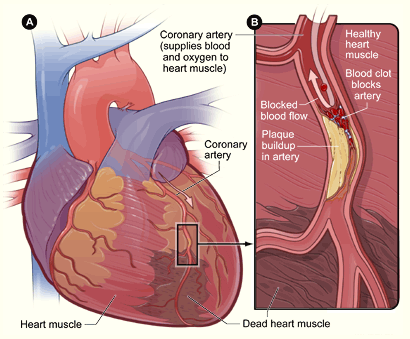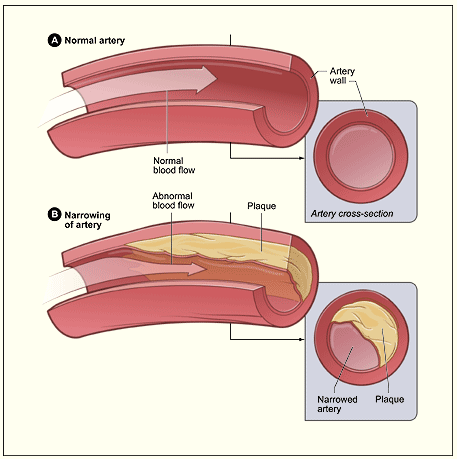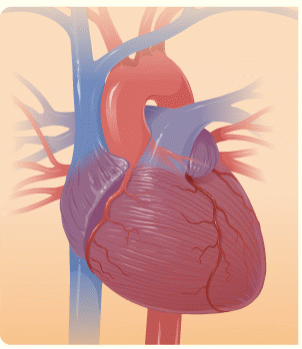It is now becoming a popular topic. Many people are now aware that heart attack is now the leading cause of death for both men and women in America. There is a need to understand that this medical problem is not a contagious disease like HIV/AIDS or Swine Flu and yet it has created so much damage. Aside from that another interesting feature of this problem is that it is preventable. There is actually a way to escape the effect of this much dreaded disease and yet every year it claims the lives of thousands of people in the United States alone. There is definitely no need to die prematurely and yet those who suffer from a heart attack can die before they have reached the prime of their lives. Heart attack can therefore be prevented provided that those people who are considered as “at risk” will be willing to change their lifestyle. This includes diet, kicking bad habits such as smoking and excessive drinking and also the need to exercise.
Overview
A government organization named the National Heart Lung and Blood Institute (NHLBI) has this to say about this medical condition: “A heart attack occurs when blood flow to a section of the heart muscle becomes blocked. If the flow of blood is not restored quickly, the section of heart muscle becomes damaged from lack of oxygen and begins to die” (NHLBI, 2008). Blood flow is very important and therefore there is a need to prevent blockage in order to prevent a heart attack. Listed as follows are the other names for a heart and this will give us the ability to know more of this disease: 1) myocardial infraction; 2) acute myocardial infarction; 3) acute coronary syndrome; 4) coronary thrombosis; and 5) coronary occlusion. These are just some of the names taken from various journals and even official websites that carry information regarding this very serious medical problem.

The number one reason for heart attacks is due to coronary artery disease or CAD. The less frequent cause is due to severe spasm or tightening of a coronary artery (NHLBI, 2010). Coronary artery disease or CAD is the result of a build-up of fatty material called plaque on the inner walls of the coronary arteries. This does not happen overnight and requires a lengthy period of time. This means that the patient has no idea how to properly take care of his or her body and so this is the result.
Plaque build-up is the result of an abnormal level of cholesterol in the body. This is of course due to an unhealthy diet such going frequently to fast food restaurants and eating food that have too much fat content in them. It is therefore urgent to educate the general public and the American people that it is time to lessen their addiction on fast food diet. They also have to be told regarding the negative consequences of not thinking about the kind of food that they eat on a daily basis. Eating should be seen as an activity not only to ease the pain of hunger but also as a means to nourish the body with nutritious food as well as prevent diseases.

In the body’s circulatory system the continuous eating of unhealthy food rich in facts can easily lead to CAD. , the consumption of unhealthy food rich in fats will significantly increase the chances of acquiring CAD. While it is important to watch the food intake of the person it must also be added that there are other risk factors and other habits that can help cause a heart attack. It must be added though that even if the individual is following a strict diet there is still a possibility that he or she will die prematurely from a heart attack. This is because the second major cause of a heart attack is severe spasm or tightening of the artery. Medical experts are not yet in agreement when it comes to why a spasm or tightening of the artery does occur but there are those who argue that these factors can really contribute to it and these are: 1) drug abuse e.g. cocaine; 2) emotional stress or pain; and 3) cigarette smoking.

When it comes to spasm or tightening of the artery the government and the local community must focus on smoking because unlike cocaine that is a banned substance, cigarettes can be easily purchased almost anywhere. Thus, many people smoke without really being aware of the health risks that this habit can create in the body of a heavy smoker. Smoking is an urgent concern because unlike cocaine and other illicit drugs it is highly accessible. For example no juvenile can be imprisoned if they are found to carry cigarettes, however there is a heavy penalty if a young person is caught with the possession of drugs such as cocaine.
Since the early 1960’s the United States government is doing the best that it can to inform people regarding the harmful effects of smoking (Spijkerman, 2007). It is therefore important to continue with these types of information campaign so that more people will know that smoking is not just another harmless activity.
There is a connection between improper diet, obesity, lack of exercise and smoking cigarettes. Improper diet and the consumption of food rich in fat will cause obesity. When a person is overweight then there is a higher amount of fat in the body. This will of course contribute to plaque build-up, “If you’re overweight … you have a greater chance of having abnormal levels of blood fats” (NHLBI, 2010). This is problem is even made more serious by the lack of exercise in America today.
If the person who is into an unhealthy lifestyle such as consuming fatty foods and does not exercise on a regular basis and then on top of it all also smokes then that person is at a high risk of someday experiencing a heart attack. This kind of lifestyle will significantly increase the likelihood of premature death due to CAD. Prevention must therefore center on the following factors: 1) diet; 2) obesity and the need for exercise or increase physical activity; and 3) the need to stop smoking cigarettes.
Prevention
It is important to stress out that in order to reduce the chance of developing heart attacks there is a need for education and intervention. Those who are at grave risk are the people who are obese, have high cholesterol, does not exercise and smoke regularly. Health education must focus on the importance of a healthy diet. Everybody must be made to understand that one sure way of reducing the chances of having CAD is to consume a variety of highly nutritious foods and drinks and at the same time to limit the eating of foods that contain saturated and trans fats, cholesterols, sugars, and salt (Miner, 2008). There is also the need to eat more fruits and vegetables.
When it comes to the problem of obesity, the main goal must be to change the behavior of the person when it comes to eating right and doing exercise on a regular basis. The person must be made aware of the positive impact of exercise and what happens to the body if the person becomes sedentary, always sitting down and doing nothing that exercise the heart and the muscles of the body. There are many researchers who discovered that increasing physical activity is the best way to lose weight when this is done with proper diet (Meriwether, Lobelo, & Pate, 2008). A recent report from the Coronary Artery Risk Development in Young Adults (CARDIA) revealed that overweight adults who learned to reduce their weight and then maintain it for 15 years did reduce their chances of developing heart problems (LaFontaine, 2008). This can also mean that attaining the correct weight will result in more health benefits.
When it comes to heavy smokers they must know and clearly understand the risks associated with smoking cigarettes (Spijkerman, 2007). Researchers are now convinced that, “Cigarette smoking is a strong risk factor for acute ischemic cardiac events such as myocardial infarction and sudden death” (Karakaya et al., 2007). Unfortunately, these things are easier said than done. There is therefore the need to have a more focused approach. For example, members of the Body & Soul Project, which is a collaborative effort between the National Cancer Institute and the American Cancer Society decided to use the resources of churches to help those who have health problems. This project was created based on the idea that the leaders and members of a particular church can effectively inspire, encourage, and guide those who are in great need for such types of assistance (Campbell, 2007). Therefore, it is clear that education is not enough, there is also the need to have effective intervention strategies.
Discussion
There is a clear connection between improper diet, obesity, and cigarette smoking when it comes to increasing the likelihood of developing CAD. The frequent consumption of cholesterol rich foods can also lead to the steady build-up of plaque overtime. It is easy to understand that food and the way people eat is not done in a random manner but is a byproduct of social factors. Therefore, it is not enough to simply talk about issues and develop an information campaign without considering the social aspect of the American diet. If health education becomes the main strategy for reducing the heart attacks in America then it must be used correctly such as the strategic targeting families not only school children.
Aside from raising the awareness level when it comes to food rich in fat, there is also the need to remind people that exercise or increasing the physical activity of Americans can reduce the incidence of CAD. Obesity has been found to significantly increases the level of harmful fats in the body and this will begin a chain reaction of problems that will lead to a heart attack. Again, it must be stressed out that it is not merely enough to bombard people with information. The message about the benefits of diet and exercise must be taught in a comprehensible manner that can lead to change in behavior.
Conclusion
Health education and intervention strategies must be made after considering social factors. One has to consider culture and the way people see diet and exercise and even the harmful vices that they are doing at present such as smoking. Aside from that it is very clear that that are many people who do not have the willpower to make the right choice. This kind of people needs help from others. They require constant encouragement and guidance so that they will know which way to go. The Body & Soul project must be cited as a good example on how to achieve these goals. It must be pointed out that there is a positive impact if church-based programs can be used to help educate people regarding health issues. The religious leaders and the members of the church will help create an environment that will encourage participation from many and then also create a system that will help them change their behavior.
References
Campbell, M. et al. (2007). Process Evaluation of an Effective Church-Based Diet Intervention: Body and Soul. Health Education Behavior. Sage Publications 34(6): 864-880.
Karakaya, O. et al. (2007) Acute Effect of Cigarette Smoking on Heart Rate Variability. Angiology. Sage Publications. 58(5): 620-624.
LaFontaine, T. (2008). Physical Activity: The Epidemic of Obesity and Overweight Among Youth: Trends, Consequences, and Interventins. American Journal of Lifestyle Medicine. Sage Publications. 2(1): 30-36.
Meriwether, R., F. Lobelo & R. Pate. (2008). Clinical Interventions to Promote Physical Activity in Youth. American Journal of Lifestyle Medicine. Sage Publications. 2(1): 7-25.
Miner, M. (2008). Patient Education: This Practitioner’s Ignorance of Diet, Nutrition, and Exercise: A Call to Education. American Journal of Lifestyle Medicine. Sage Publications 2(1): 43-45.
National Heart Lung and Blood Institute. (2010). “What is a Heart Attack?” Web.
Spijkerman, R. (2007). Perceptions of Smoking and Nonsmoking Peers: The Value of Smoker and Nonsmoker Prototypes in Predicting Onset and Regular Smoking Adolescents. Health Education & Behavior. Sage Publications. 34(6). 897-910.